All the solutions provided in McGraw Hill My Math Grade 3 Answer Key PDF Chapter 11 Lesson 2 Solve Capacity Problems will give you a clear idea of the concepts.
McGraw-Hill My Math Grade 3 Answer Key Chapter 11 Lesson 2 Solve Capacity Problems
Math in My World
Example 1
Emily used 240 milliliters of lemon juice and 960 milliliters of water to make lemonade. How many milliliters of lemonade will she make?
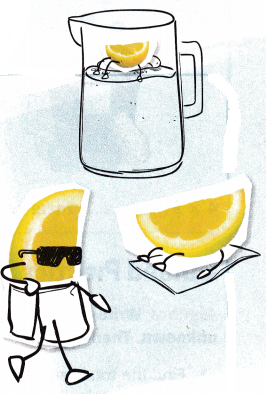
Add to find the unknown.
240 + 960 = ?
240 + 960 = ____________ milliliters
The unknown is ____________ milliliters.
Emily will make ____________ milliliters of lemonade.
Answer:
Given,
Emily used 240 milliliters of lemon juice and 960 milliliters of water to make lemonade.
240 + 960 = 1200 milliliters
The unknown is 1200 milliliters.
Emily will make 1200 milliliters of lemonade.
Example 2
The total capacity of 8 pitchers is 24 liters. What is the capacity of each pitcher if each has an equal amount of lemonade? Write an equation with a symbol for the unknown. Then solve.
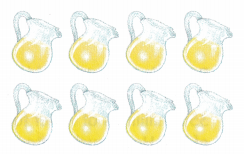
Find the unknown. 24 ÷ 8 = __________
There are ____________ liters in each of the pitchers.
The unknown is ____________.
Check:
Use the inverse operation to check.
8 × 3 = 24 The answer is reasonable.
Answer:
Given,
The total capacity of 8 pitchers is 24 liters.
Find the unknown. 24 ÷ 8 = 3
There are 3 liters in each of the pitchers.
The unknown is 3.
Example 3
Dylan is helping his dad wash the car. His dad filled up 2 buckets with soapy water and 2 buckets with clean water. The capacity of each bucket is 9 liters. What is the total capacity of the 4 buckets?
Find 4 × 9. Label the capacity of each bucket.
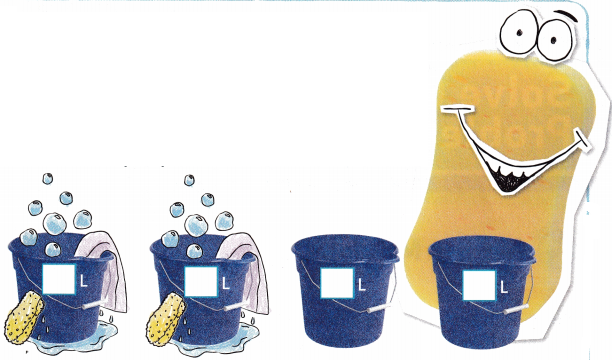
4 × 9 = ____________. There are ____________ liters of water in the buckets.
Answer:
Given,
Dylan is helping his dad wash the car. His dad filled up 2 buckets with soapy water and 2 buckets with clean water. The capacity of each bucket is 9 liters.
4 × 9 = 36
There are 36 liters of water in the buckets.
Talk Math
Look back at Exercise 2. How did you know what operation to use?

Answer:
The total capacity of 8 pitchers is 24 liters. What is the capacity of each pitcher if each has an equal amount of lemonade? Write an equation with a symbol for the unknown.
The total capacity is given and the capacity of total pitchers is given. To find the capacity of each lemonade we have to use the division operation.
Guided Practice
Algebra Write an equation with a symbol for the unknown. Then solve.
Question 1.
Find the total capacity of the liquid shown in the containers below.
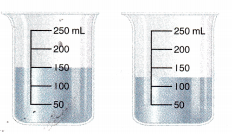
Answer:
The capacity of first container = 150 mL
The capacity of second container = 125 mL
150 + 125 = 275 mL
Question 2.
Peyton’s tea kettle holds 2 liters, or 2,000 milliliters of water. She uses 350 milliliters of water for a cup of tea. How much water is left in the kettle?
Answer:
Given,
Peyton’s tea kettle holds 2 liters, or 2,000 milliliters of water. She uses 350 milliliters of water for a cup of tea.
2000 – 350 = 1650 milliliters
Thus 1650 milliliters of water is left in the kettle.
Independent Practice
Algebra Write an equation with a symbol for the unknown. Then solve.
Question 3.
Find the total capacity of the liquid shown in the containers below.

Answer:
The capacity of the first container = 50 mL
The capacity of the second container = 100 mL
50 + 100 = 150 mL
Question 4.
How much liquid would be left if you poured out 250 milliliters?
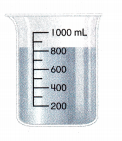
Answer:
The liquid in the container is 800 mL
800 – 250 = 550 mL
Question 5.
If you equally pour this liquid into three containers how much liquid would be in each container?
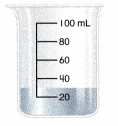
Answer:
The liquid in the container is 30 mL
If it is equally into 3 containers then 30/3 = 10
Thus 10 mL of liquid would be in each container.
Question 6.
The capacity of 1 pitcher is shown. What is the total capacity in liters, of 2 pitchers?
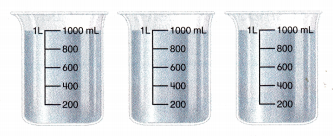
Answer:
Given,
The capacity of 1 pitcher is shown.
The capacity of three containers is 1000 + 1000 + 1000 = 3000 = 3 liters
Question 7.
One small carton of milk is 250 milliliters. One large carton of milk is 1,000 milliliters, or 1 liter. Circle the correct number of small milk cartons equal to 1,000 milliliters, or 1 liter.
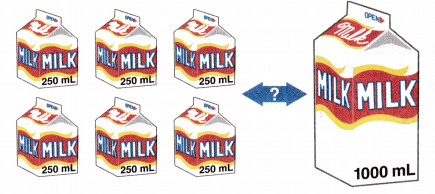
250 + ____________ + ___________ + __________ = 1,000 milliliters or 1 L
Answer:

250 + 250 +250 + 250 = 1000 milliliters or 1 liter
Problem Solving
Question 8.
Carlos’ aquarium holds 81 liters of water. His pail holds 9 liters of water. How many pails of water does it take to fill the aquarium?
Answer:
Given,
Carlos’ aquarium holds 81 liters of water. His pail holds 9 liters of water.
81 ÷ 9 = 9
Thus it takes 9 pails of water to fill the aquarium.
Question 9.
There are 600 milliliters of water in Lisa’s vase. If she pours out 254 milliliters of water, how much water will be left in the vase?
Answer:
Given,
There are 600 milliliters of water in Lisa’s vase.
she pours out 254 milliliters of water
600 – 254 = 346 milliliters of water
Thus 346 milliliters of water will be left in the vase.
Question 10.
Tara has 3 coolers with 7 liters of lemonade in each. How many liters of lemonade does she have in all?
Answer:
Tara has 3 coolers with 7 liters of lemonade in each.
3 × 7 = 21 liters of lemonade in all.
Question 11.
Mathematical PRACTICE Use Mental Math Sean’s mother bought 2 bottles of shampoo. Each bottle contains 800 milliliters of shampoo. How many milliliters of shampoo did Sean’s mother buy?

Answer:
Given,
Sean’s mother bought 2 bottles of shampoo. Each bottle contains 800 milliliters of shampoo.
800 × 2 = 1600 milliliters of shampoo
Thus Sean’s mother buys 1600 milliliters of shampoo.
HOT Problems
Question 12.
Mathematical PRACTICE Plan Your Solution A cooking pot holds 1,000 milliliters of sauce. Then half of the sauce is used. Another 300 milliliters of sauce is added back in. Once again, half of the pot of sauce is used. How many milliliters of sauce is needed in order to fill the pot again?
Answer:
A cooking pot holds 1,000 milliliters of sauce. Then half of the sauce is used.
1000 – 500 = 500 milliliters
Another 300 milliliters of sauce is added back in.
500 + 300 = 800 milliliters
Once again, half of the pot of sauce is used.
800 – 400 = 400 milliliters
1000 – 400 = 600 milliliters
So, we need to add 600 milliliters in order to fill the pot again.
Question 13.
Building on the Essential Question Explain how you might decide whether to measure capacity in milliliters or liters.
Answer:
Capacity is the amount of liquid that an object can hold. The metric system of measurement uses the units of liter and milliliter. You would use liters to measure the amount of water in a water bottle or the amount of gasoline in a gas can and a milliliter is a very small unit of measurement.
McGraw Hill My Math Grade 3 Chapter 11 Lesson 2 My Homework Answer Key
Practice
Algebra Write an equation with a symbol for the unknown. Then solve.
Question 1.
How much liquid would there be if you poured another 35 mL into the container?

Answer:
The liquid in the above container is 115 mL
115 + 35 = 150 mL
Thus it would be 150 mL if you poured another 35 mL into the container.
Question 2.
If you poured this liquid in equal amounts into 10 separate containers, how much liquid would be in each container?
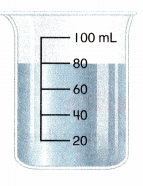
Answer:
The liquid in the above container is 80 mL
80 ÷ 10 = 8
So, If you poured this liquid in equal amounts into 10 separate containers, it would be 10 mL in each container.
Problem Solving
Question 3.
Each stew pot can hold 6 liters of stew. If there are 5 stew pots, how much stew could be made at one time?
Answer:
Given,
Each stew pot can hold 6 liters of stew.
5 stew pots = x
x = 5 × 6
x = 30 liters
So, 30 liters of stew could be made at one time.
Question 4.
Mathematical PRACTICE Be Precise Kathleen needs 550 milliliters of cream for a recipe. Does Kathleen have enough cream for her recipe? Explain.
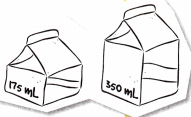
Answer:
Kathleen needs 550 milliliters of cream for a recipe.
175 + 350 = 525 milliliters
No Kathleen does not have enough cream for her recipe.
Question 5.
Glenna put 850 milliliters of gravy into a gravy boat. John poured 75 milliliters of gravy on his mashed potatoes. How much gravy is left in the gravy boat?
Answer:
Given,
Glenna put 850 milliliters of gravy into a gravy boat.
John poured 75 milliliters of gravy on his mashed potatoes.
850 – 75 = 775 milliliters
Thus 775 milliliters gravy is left in the gravy boat.
Question 6.
Mrs. Hudson made 25 liters of punch to equally pour into 5 punch bowls. How much punch will be poured into each bowl?
Answer:
Given,
Mrs. Hudson made 25 liters of punch to equally pour into 5 punch bowls.
25 ÷ 5 = 5
Thus 5 liters of punch will be poured into each bowl.
Question 7.
Claude has 24 milliliters of mouthwash left. He will use the same amount of mouthwash each day for the next three days. How much mouthwash does Claude use each day?
Answer:
Given,
Claude has 24 milliliters of mouthwash left. He will use the same amount of mouthwash each day for the next three days.
24 ÷ 3 = 8
Thus Claude uses 8 milliliters of mouthwash every day.
Test Practice
Question 8.
How much honey does Omar use in five days?

(A) 35 milliliters
(B) 25 milliliters
(C) 24 milliliters
(D) 11 milliliters
Answer:
From the above table
5 × 5 = 25 milliliter
Option B is the correct answer.